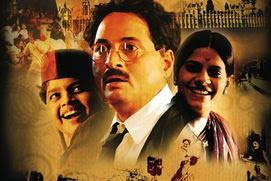
Cinema is a part of our lives now and many of us are passionate about it. All of us owe it to one man who brought this beautiful medley of moving images into our lives. Had Dhundiraj Govind Phalke alias Dada Saheb Phalke not dreamt his almost impossible dream of bringing motion pictures to India as far back as in 1913, we would not have had such a large film industry today in this country.
I heard of Harishchandrachi Factory (2009), the Marathi biopic that was made on Phalke’s life mission, earlier, when it was announced as official entry to Oscars from India. I half-expected it to be a melodramatic presentation of the travails and tribulations of the Father of Indian Cinema. But when I actually happened to watch it thanks to a movies channel, I felt a breath of fresh air that I haven’t in a long time.
Debut Director from Marathi stage Paresh Mokashi portrays the spirit of Phalke in an authentic, but engaging, simple and at times, hilarious manner. Phalke’s passion is only matched by his lightness of demeanour. A man of few means, the enterprising Marathi is a possessed man, once he was mesmerized by the moving images of an English film that he watches in a small tent house.
In his audacious venture of making the first Indian movie, his family, including his wife Saraswati, plays a large part. His long journey to London to master the making of motion picture, his decision to make a ‘screen drama’ on Raja Harishchandra, the financial difficulties he faces, his failed trails with actors – they are depicted in such a humorous and understated manner, that some may even fail to see the gigantic achievement of Phalke underlying this roller-coaster journey.
The character of Phalke, essayed brilliantly by Nandu Madhav, a Marathi stage artiste, is a veritable mix of passion, perseverance, determination, grit but most importantly what shines through is his flair for making light of his own travails and his unbridled enthusiasm. His ability to carry through not only his family – his wife sells off the furniture, her jewellery to fund the film, his son plays a character – but also anyone who he interacts with is uplifting to watch.
There are two episodes in the film which amusingly illustrate the hostile environment in which he had to make his picture. A moving drama was not even comprehensible to most of Phalke’s peers. When Phalke’s efforts to cast a woman for the character of Taramati, fail, as a last resort, he visits the brothels of Mumbai. While one madam says it would bring dishonour to the prostitutes to play in a ‘white man’s drama’, another was dragged away by the paramour, aghast at the sinful venture! In another episode, a young man playing a small character in the picture, describes how the bride-to-be’s family got scared and ran away when told about his acting in a ‘moving picture’.
This historically accurate film captures the ethos of the times brilliantly, ably supported by a competent technical team. The way the director brings together heart and humour, without being overtly sentimental or adulatory, is actually touching. It’s a gem of a film, and opens your eyes to the strengths of Marathi film making.
The film comes with English sub-titles, but interestingly, Telugu viewers can follow the dialogues easily, probably because Marathi has a liberal mix of Sanskrit and Urdu words.
Why the Telugu film industry, one of the largest in the country, cannot even think of making such an attempt in our own context is sad, to say the least!